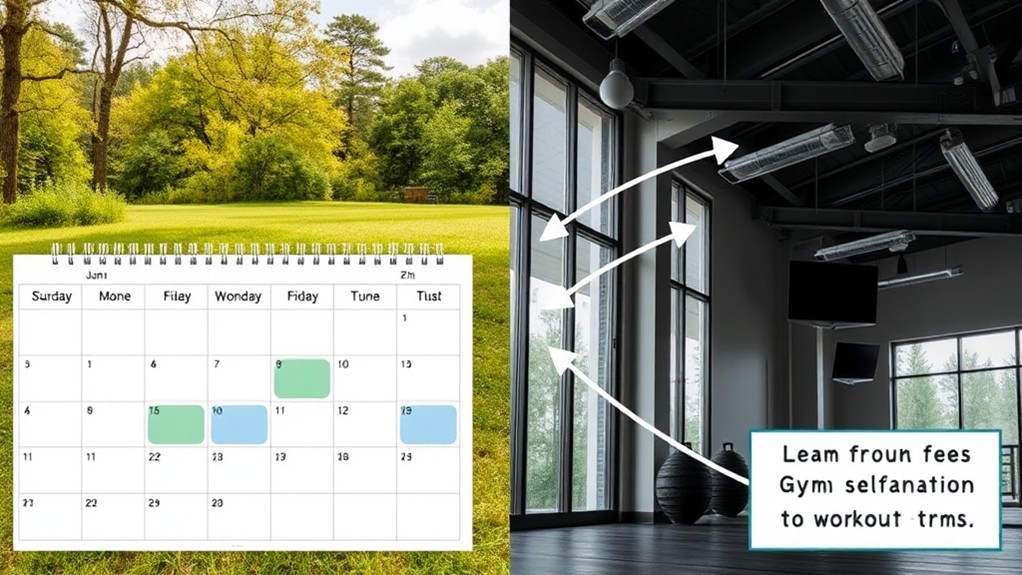To combine outdoor and indoor training effectively, you need a balanced approach that utilizes the strengths of each environment. Aim for a ratio of 2-3 indoor sessions for every outdoor ride, adjusting as needed to prevent burnout and maintain engagement. Structure your indoor training days to focus on metrics like heart rate and power output, while outdoor rides improve your fitness through varied terrains and conditions. By scheduling thoughtfully and adapting to weather conditions, you'll be able to simulate race-specific scenarios, develop specific skills, and stay motivated – and by doing so, you'll reveal the full potential of your training.
Balancing Act: Indoor and Outdoor
You've likely experienced the dilemma of deciding whether to take your bike ride indoors or outdoors. This decision is essential, as both environments offer unique benefits that can improve your cycling experience.
Indoor advantages include a controlled environment, minimizing weather-related disruptions and allowing for structured workouts focused on metrics like heart rate and power output. This controlled setting allows you to fine-tune your training, ensuring you're meeting your fitness goals.
On the other hand, outdoor rides present outdoor challenges, such as varied terrains and conditions, which contribute to improved general fitness and greater calorie burn. Factors like wind resistance and elevation changes push your body harder, resulting in a more intense workout.
To optimize your fitness efficiency, consider a suggested ratio of 2-3 indoor sessions for every outdoor ride. This balance provides varied training stimuli, preventing burnout and keeping engagement high.
Weathering the Conditions
As you strive to find the perfect balance between indoor and outdoor training, one factor stands out as a significant influencer: the weather. Favorable weather conditions can enhance your motivation and enjoyment, making outdoor riding a preferred choice. Conversely, inclement weather necessitates indoor workouts to maintain training consistency.
To make the most of your training, it is crucial to adapt to seasonal weather patterns. Here's a breakdown of how to adjust your training plans according to the weather:
| Season | Weather Conditions | Training Adjustments |
|---|---|---|
| Spring | Unpredictable, windy | Incorporate indoor strength training to build endurance |
| Summer | Hot, humid | Schedule outdoor rides early morning or evening to avoid heat exhaustion |
| Autumn | Cooler, windy | Focus on high-intensity interval training (HIIT) to improve cardiovascular fitness |
| Winter | Cold, snowy | Shift to indoor workouts, incorporating virtual rides and strength training |
| Any | Inclement weather | Move to indoor training, focusing on specific skills like pedaling technique |
Structuring Your Workout Schedule

By structuring your workout schedule thoughtfully, you'll be able to strike a balance between indoor and outdoor training that supports your thorough fitness goals.
To achieve this balance, consider the following guidelines:
- Schedule indoor workouts: Aim for three structured training days per week, such as Tuesday, Thursday, and Saturday, to create a consistent routine.
- Incorporate outdoor rides: Use weekends for longer, easier outdoor rides to increase your Training Stress Score (TSS) while allowing for recovery from indoor sessions.
- Adjust your frequency: Aim for a ratio of 2-3 indoor sessions for every outdoor ride, adjusting based on training goals and performance metrics.
- Prioritize power goals: Guarantee that outdoor sessions focus on endurance or skill development as needed, while indoor workouts simulate race-specific scenarios.
Skill Development and Specificity
Cycling skills are honed on varied terrain, and outdoor rides offer a unique opportunity to practice and refine them. You can work on cornering techniques, climbing drills, and descending strategies, which are vital for competitive cycling.
By incorporating skill-specific riding, such as cyclo-cross or mountain biking techniques, you can reinforce the strength and endurance you've built indoors. During outdoor rides, try integrating skill drills, like interval sprints or cadence variations, to solidify the concepts learned in structured indoor sessions.
Regularly assess your skill levels during outdoor rides to identify areas needing improvement, and then tailor your indoor workouts to address those deficits effectively. This approach will help you adapt your skills to real-world scenarios, a significant aspect of peak performance in competitions.
Staying Motivated and Compliant

While indoor training provides a controlled environment to focus on specific skills and fitness goals, outdoor riding brings a unique set of benefits that can greatly improve your motivation and enjoyment.
To stay motivated and compliant with your training schedule, consider the following strategies:
- Set specific goals: Define objectives for both indoor and outdoor sessions to increase focus and commitment.
- Build community support: Join a group or find a riding buddy to foster social motivation and make workouts more enjoyable.
- Mix up your routine: Incorporate varied workout options and seasonal adaptations to prevent boredom and keep your training invigorating.
- Track progress and celebrate: Monitor your achievements and recognize your progress, whether through personal tracking or community recognition, to reinforce motivation.
Frequently Asked Questions
Do You Prefer to Exercise Indoors or Outdoors Training?
You likely prefer exercising outdoors for the motivation that comes with varied scenery and new air, but you likewise appreciate the indoor benefits of controlled conditions and precise performance tracking, allowing you to mix and match based on your mood and goals.
How to Transition From Indoor to Outdoor Cycling?
You're ready to transition from indoor to outdoor cycling! Start by making gear adjustments, like swapping your indoor tires for outdoor ones, and consider weather conditions to plan a comfortable ride, ensuring a smooth transition.
